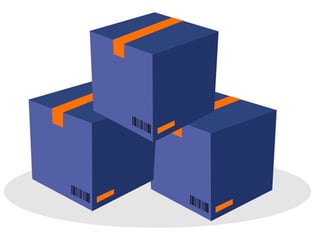Originally published on May 27, 2020, updated February 9, 2024
Menu
Join Our Email List
- Receive our monthly newsletter.
- Stay up to date on Amazon policies.
- Get tips to grow your business.
Have you ever received a package and wondered why so much packing material was wasted?
Perhaps excess bubble wrap was bound tightly around the item to prevent it from being scratched by the shipping box’s interior while in transit. Crumbled brown paper and air-filled bags – or worse, copious amounts of foam peanuts – fill the void. All packed tightly in a shipping box four times the size of the physical item you ordered.
After removing the item from its shipping box, you are faced with package adhesives, wire ties, plastic clamshells, poly bags, more cardboard, and zip ties. Yes, another layer of work to release that item you’ve been eagerly anticipating for the past week or two. After employing a box cutter, wire cutters, and scissors while amassing a garbage bag full of packing materials destined for a landfill, your item is finally free.
Sound frustratingly familiar? Amazon thinks so. That’s why they first introduced Certified Frustration-Free Packaging, or FFP, back in 2008 and turned it into a standard way of doing business in recent years.
 At its core, Certified Frustration-Free Packaging is an Amazon program designed to simplify a customer’s package-opening experience while reducing waste and making the shipment’s journey more efficient, both physically and monetarily.
At its core, Certified Frustration-Free Packaging is an Amazon program designed to simplify a customer’s package-opening experience while reducing waste and making the shipment’s journey more efficient, both physically and monetarily.
A smaller, lighter box or padded envelope is less expensive to ship.
Manufacturers are tasked to rethink their packaging to meet a variety of strict guidelines, such as reducing the amount of materials required to pack an item, using only recyclable materials, removing zip ties, and decreasing the overall size of shipping packages.
Think about it: a smaller, lighter box or padded envelope is less expensive to ship. It takes up less physical space therefore allowing for more items to fit in one truckload, which in return reduces fuel costs and carbon emissions. Every little reduction adds up. For example, Amazon reported that in 2017 their FFP initiatives eliminated over 244,000 tons of packaging materials, which translates to roughly 305 million shipping boxes.
Amazon works with merchants to create the packaging with the ultimate goal of delighting customers. Certified frustration-free packaging means that the packaging has been designed and lab-tested to minimize the risk of damage during shipment.
Durability and structural integrity are top of mind. These package form-factors are lighter and more compact than their traditional brick and mortar counterparts making them much easier to handle during the shipment journey. They do not require additional Amazon “overboxing” before shipping out to the customer.
FFP is required for products moving through the Amazon sort process, like Amazon-owned and FBA (Fulfillment by Amazon) inventory. It does not apply to direct ship vendors who manage their fulfillment. If vendors or sellers using the Amazon sort system choose to ignore these requirements, they will be hit with $1.99 per unit chargebacks until a certified packaging method has been implemented.
Furthermore, non-compliance can hurt search results ranking and stifle the ability to participate in the Amazon Vine program.
All merchants must enroll new packaging in Amazon’s ISTA6 SIOC certification unless the longest, shortest, or median sides are less than 6” (long) x 4” (median) x 0.375” (short) in which case those items are exempt. Amazon advises brands to test their packaging ahead of submitting it to an ISTA lab partner for certification. Once a package form-factor is certified, the documentation can be submitted through Vendor Central or Seller Central along with applicable ASINs.
There are three tiers in the Certified Frustration-Free Packaging program all merchants should abide by:
The packaging must be 100 percent recyclable, easy to open and remove the item in under 120 seconds, and not require an outer box prior to shipment to a customer.
Similar criteria to Tier 1 except for the 100 percent recyclability requirement. The program was updated in 2024 and is now called Ships in Own Product Packaging (SIPP).
The package is exempt due to its smaller size, less than the 6” x 4” x 0.375” threshold. It can be placed in an outer box or padded envelope for shipment with minimal prepping needs like the addition of box filler and taping to seal the outer package.
ASINs are at risk of losing their certification if regular reports of damage are received from customers exceeding damage rate guidelines. A two-month waiver period is then activated to give merchants time to correct the packaging defects and implement the changes.
If the defects continue with newer packages received by Amazon distribution centers after this two-month period, the affected ASINs are decertified and subjected to the $1.99 per unit chargeback. In order to recertify these ASINs, they must go through the ISTA6 SIOC lab certification process again after the packaging defects have been addressed.
It might feel overwhelming to work through Certified Frustration-Free Packaging, but it is worth all of the effort in the end. A happy customer leads to higher star ratings and reviews, which in turn leads to more business for you. Plus, you can never go wrong with taking steps that help reduce waste materials from entering our environment.
Originally published on May 27, 2020, updated February 9, 2024
This post is accurate as of the date of publication. Some features and information may have changed due to product updates or Amazon policy changes.
These Stories on Amazon
14321 Winter Breeze Drive
Suite 121 Midlothian, VA 23113
Call us: 800-757-6840





Copyright© 2007-2025 eComEngine, LLC. All Rights Reserved. eComEngine®, FeedbackFive®, RestockPro®, and SellerPulse® are trademarks or registered trademarks of eComEngine, LLC. Amazon's trademark is used under license from Amazon.com, Inc. or its affiliates.
Comments (2)